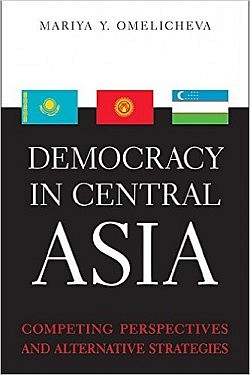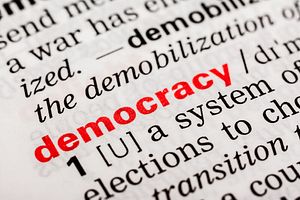The United States and Europe have spent billions on democracy programs in Central Asia, but regional regimes have mostly remained intractable autocracies. With each regional election, Western monitors are disappointed by lack of genuine choice and policy debate, while leaders claim dizzying numbers in the polls. After two decades of democratization projects we need to ask: why have the West’s efforts to promote democracy seemingly failed in Central Asia?
In a new book, Democracy in Central Asia: Competing Perspectives and Alternative Strategies, Mariya Y. Omelicheva, an associate professor of political science at the University of Kansas, explores how Central Asian regimes understand democracy and why Western efforts have been fumbling, insensitive, and ultimately unsuccessful. The Diplomat had a chance to talk to Omelicheva about the West’s democracy promotion efforts, how Russia and China have influenced regional understandings of democracy, and what potentially more successful efforts to promote change in the region should look like.
 How much of overall western engagement in Central Asia has been devoted to democracy promotion?
How much of overall western engagement in Central Asia has been devoted to democracy promotion?
Comprehensive figures on the extent of democracy assistance to Central Asian states are unavailable partly because of the multitude of actors (states and international organizations) involved in the region. The U.S. has been one of the largest donors of democracy assistance. Through the Freedom for Russia and Emerging Eurasian Democracies and Open Markets (FREEDOM) Support Act (FSA) of 1992 alone the U.S. disbursed $1.8 billion to Central Asian republics from 1992 to 2006. Although it is a considerable amount of resources, it is below the levels of assistance received by some other post-Soviet states, notably, Ukraine, Georgia, and Russia.
The EU is another major donor in Central Asia. By some estimates, the Union and its member states account for $3 billion in expenditures on democracy, governance, and related activities annually, and this amount exceeds the annual democracy expenditures of the United States.
It is also important to note that democracy assistance has been negligible compared to other forms of economic and security assistance. In the 1990s, considerably more resources were allocated for economic liberalization reforms, commercial law development, and the establishment of capital markets. This trend remained throughout the 2000s, when the overall amount of the U.S. and EU assistance to Central Asia increased following the inception of the U.S.-led global “war on terror.” The share of military aid in the total U.S. aid package to Central Asia, for example, has risen from around 5 percent throughout the 1990s to more than 30 percent since 2007.
Briefly, why has democracy promotion failed in the region?
In the book, I argue that part of the responsibility for democratic failure in Central Asia lies with the democracy promoters themselves. The ideas, values, and practices promoted by the U.S. and EU in Central Asia have been culturally insensitive, inconsistent, unimportant, and, therefore, lacking credibility for Central Asian governments and people. Western policymakers and academics have developed a sophisticated understanding of what democracy is about and this understanding emphasizes political pluralism, elections, and civic engagement, among other things. Yet, these ideas are largely divorced from how democracy and democratization are understood in Central Asia. The regional elites downgrade democracy to a lower priority than economic prosperity and security. Central Asian citizens perceive democracy as an empty ideological framework or a recipe for mayhem. These attitudes toward democracy have been bolstered by the fatigue and resentment of the Central Asian populations to the externally driven ideologies that have been a constant reality for the Central Asian societies subjected to Russian colonialism, Sovietization, and post-Soviet democratization.
You note that democracy is seen by many in the region as a universal idea but that it isn’t exactly what western nations mean by the word–what do Central Asians mean by democracy?
Let me first clarify a couple of things. To demonstrate the complexity of “democracy,” the book examines its meaning at several levels: international (how EU and U.S. vs. Russia and China portray it); national (how the Central Asian governments present democracy); and local (how Central Asian people view democracy). Only the EU and U.S. share beliefs in the universality of democracy. The Central Asian governments and people believe that democracy cannot be transferred from one context to another. They embrace a “culturally sensitive” understanding of democracy that take into account historical and cultural experiences of the peoples of the region.
For example, a common feature of the models of democracy promoted by the Central Asian governments includes a strong state personified by a strong leader. Strong leadership has been presented as consistent with the mindset of the Central Asian people and imperative for resolving their countries’ political and socio-economic challenges. Indeed, the surveys that I carried out in Central Asia confirm that the majority of people in the region embrace a variety of traditional values that would support beliefs in strong leadership. Central Asians, for example, noted the importance of respect for seniority, reverence for parents and older people, and acceptance of gender hierarchies. They also pointed out the importance of “love for motherland.” Less than a quarter of survey participants said that individualism and competitiveness (the two traits associated with democratic consciousness) were among the human qualities they possessed or found important.
Overall, the majority of Central Asians share their governments’ beliefs on the best forms of governance. Like their leaders, Central Asians prioritize economic development over political liberalization, and security and order over democratic reforms. The latter have been widely associated with political instability orchestrated from abroad. In addition, for many Central Asians democracy and economy go hand-in-hand; therefore, in their view, Central Asian variants of democracy should ensure citizens’ welfare and retain some elements of state patronage. Overall, however, I found that many Central Asians lacked a profound and critical knowledge of democracy and associated concepts. They are able to recite elements of a democratic regime (elections, parties, etc.), but they cannot, for example, articulate the essence of the “rule of law” concept or a meaning of human rights. This became clear in the focus group discussions where several participants took the position that a Muslim state, such as Iran, ruled by the Sharia law, could also be a rule of law state.
How have the Russian and Chinese understandings of democracy influenced Central Asians?
Both the Russian and Chinese governments have been using their “soft power” tools to furnish “democracy” with alternative meanings. In one sense, promoted by Russia and China, democracy stands for a principle of equality of various ideological perspectives.
Another perspective on democracy promoted by Russia and China calls for recognizing multiple and unique forms of governance consistent with each country’s historical practices and present-day socio-economic and political conditions. Both perspectives have been very popular with the Central Asian regimes.
The state holds a prominent position in the models of democracy and development promoted by Moscow and Beijing, just like it does in the models of democracy promoted by the Central Asian leaders. A strong economy is a linchpin of a strong state, and it can only be accomplished through the centrally managed reform processes. Therefore, economic development must precede political liberalization, another tenet that underlies the Central Asian models of democracy. Both Russia and China have been outspoken critics of the U.S. and EU democratization projects, which have been blamed for instability and revolutions jeopardizing political and economic gains that these countries have made.
The Russian and Chinese frames have been more compatible with the local ways of thinking in Central Asia, not only because these alternative models find better resonance with the authorities of Central Asian states, but also because they provide the Central Asian leadership with the ideological cushion for resisting international democratization.
Is there a more effective way to encourage respect for human rights–religious freedom, press freedom, and so on?
Creating democracy where it has not previously existed requires a cultural change, which cannot be brought about without deeper knowledge and attitudinal changes toward these societies. Western democracy promoters have been frequently engaged in the rhetoric of “moral posturing,” “political demonizing,” and “finger pointing,” which are counterproductive. A more tactful and informed engagement with these societies is a project of many years. It will require a change from the short-term democracy projects that dominate democracy assistance to long-term programs. It will also require a transition from ethnocentric to more culturally sensitive, case-specific, and intelligent practices.
In terms of the specific examples, instead of using projects that emphasize short-term observable changes in the levels of citizens’ participation in elections, democracy promoters should concentrate on the creation of a sustainable culture of political engagement and participation. Funding the organization of free and fair elections in societies that lack independent media, civil society networks, and free speech will not only result in the waste of resources, but also invalidate democracy, making further democratic gains more difficult. Investing resources into civic development should come prior to the sponsorship of elections.
However, civil society projects should not be copied from advanced democracies but sufficiently contextualized. For example, instead of, or in addition to, transmitting general knowledge about democracy and liberties through civil education projects, initiatives aiming at the attitudinal change will place greater emphasis on the development of critical thinking, skills of deliberation, and appreciation for political and ideological pluralism. The problem with the short-term training workshops or new civics courses introduced into the curriculum of the Central Asian schools is that they are largely impotent in nurturing the critical capacities and political competencies of the recipients of education. An alternative approach calls for a kind of democratic education that aims at producing qualities of tolerance, enthusiasm for debate, and other critical competencies of the Central Asian people.

































